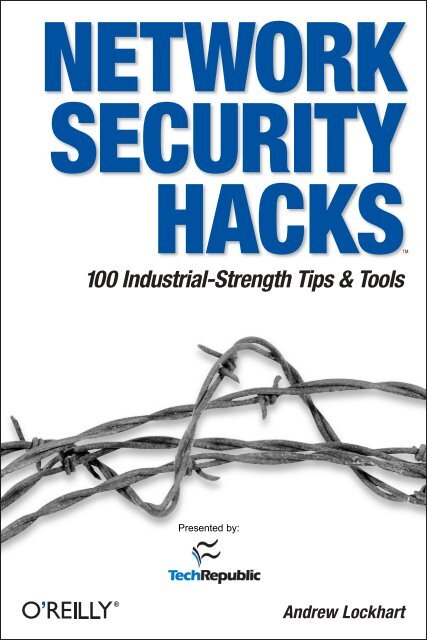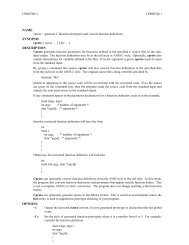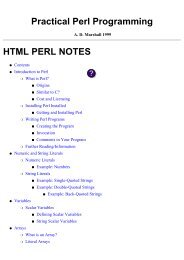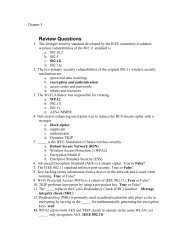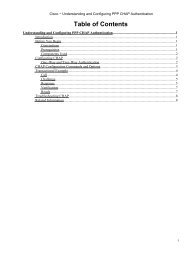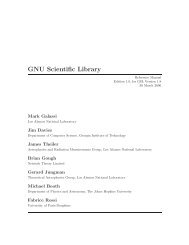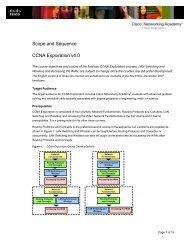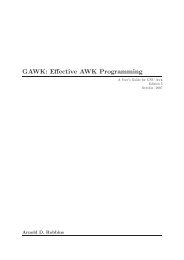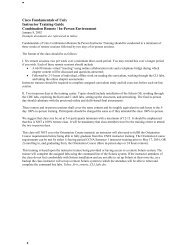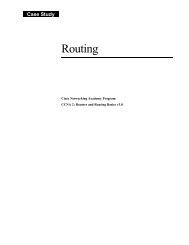You also want an ePaper? Increase the reach of your titles
YUMPU automatically turns print PDFs into web optimized ePapers that Google loves.
NETWORK<br />
SECURITY<br />
HACKS<br />
100 Industrial-Strength Tips & Tools<br />
TM<br />
Presented by:<br />
Andrew Lockhart
HACK<br />
#86 <strong>Write</strong> <strong>Your</strong> <strong>Own</strong> <strong>Snort</strong> <strong>Rules</strong><br />
H A C K<br />
#86<br />
Hack<br />
<strong>Write</strong> <strong>Your</strong> <strong>Own</strong> <strong>Snort</strong> <strong>Rules</strong><br />
Customize <strong>Snort</strong> for your own needs quickly and easily by leveraging its<br />
flexible rule engine and language.<br />
One of the best features of <strong>Snort</strong> is its rule engine and language. <strong>Snort</strong>’s rule<br />
engine provides an extensive language that enables you to write your own<br />
rules, allowing you to extend it to meet the needs of your own network.<br />
A <strong>Snort</strong> rule can be broken down into two basic parts, the rule header and<br />
options for the rule. The rule header contains the action to perform, the protocol<br />
that the rule applies to, and the source and destination addresses and<br />
ports. The rule options allow you to create a descriptive message to associate<br />
with the rule, as well as check a variety of other packet attributes by<br />
making use of <strong>Snort</strong>’s extensive library of plug-ins.<br />
Here’s the general form of a <strong>Snort</strong> rule:<br />
action proto src_ip src_port direction dst_ip dst_port (options)<br />
When a packet comes in, its source and destination IP addresses and ports<br />
are then compared to the rules in the ruleset. If any of them are applicable to<br />
the packet, then the options are compared to the packet. If all of these comparisons<br />
return a match, then the specified action is taken.<br />
<strong>Snort</strong> provides several built-in actions that you can use when crafting your<br />
rules. To simply log the packet that matches a rule, use the log action. The<br />
alert action generates an alert using the method specified in your configuration<br />
file or on the command line, in addition to logging the packet. One nice<br />
feature is that you can have very general rules and then create exceptions by<br />
writing a rule that uses the pass action. This works especially well when you<br />
are using the rules distributed with <strong>Snort</strong>, but are frequently getting false<br />
positives for some of them. If this happens and it’s not a security risk to<br />
ignore them, you can simply write a pass rule for it.<br />
The last two built-in rule actions are used together to dynamically modify<br />
<strong>Snort</strong>’s ruleset at runtime. These are the activate and dynamic actions. <strong>Rules</strong><br />
that use the dynamic action are just like a log rule, except they will be considered<br />
only after they have been enabled by an activate rule. To accomplish<br />
this, <strong>Snort</strong> enforces the use of the activates and activated_by rule options<br />
in order to know what dynamic rules to enable once an activate rule has<br />
been triggered. In addition, dynamic rules are required to specify a count<br />
option in order for <strong>Snort</strong> to limit how many packets the rule will record.<br />
For instance, if you wanted to start recording packets once an exploit of a<br />
SSH daemon on 192.168.1.21 was noticed, you could use a couple of rules<br />
similar to these:<br />
#86<br />
240 | Network Intrusion Detection
HACK<br />
<strong>Write</strong> <strong>Your</strong> <strong>Own</strong> <strong>Snort</strong> <strong>Rules</strong> #86<br />
activate tcp any any -> 192.168.1.21 22 (content:"/bin/sh"; activates:1; \<br />
msg:"Possible SSH buffer overflow"; )<br />
dynamic tcp any any -> 192.168.1.21 22 (activated_by:1; count:100;)<br />
These two rules aren’t completely foolproof, but if someone were to run an<br />
exploit with shell code against an SSH daemon, it would most likely send<br />
the string /bin/sh in the clear in order to spawn a shell on the system being<br />
attacked. In addition, since SSH is encrypted, strings like that wouldn’t be<br />
sent to the daemon under normal circumstances. Once the first rule is<br />
triggered, it will activate the second one, which will record 100 packets and<br />
then stop. This is useful, since you might be able to catch the intruder<br />
downloading or installing a root kit within those first few packets and be<br />
able to analyze the compromised system much more quickly.<br />
You can also define custom rule actions, in addition to those that <strong>Snort</strong> has<br />
built-in. This is done with the ruletype keyword:<br />
ruletype redalert<br />
{<br />
type alert<br />
output alert_syslog: LOG_AUTH LOG_ALERT<br />
output database: log, mysql, user=snort dbname=snort host=localhost<br />
}<br />
This custom rule action tells <strong>Snort</strong> that it behaves like the alert rule action,<br />
but specifies that the alerts should be sent to the syslog daemon, while the<br />
packet will be logged to a database. When defining a custom action, you can<br />
use any of <strong>Snort</strong>’s output plug-ins, just as you would if you were configuring<br />
them as your primary output method.<br />
<strong>Snort</strong>’s detection engine supports several protocols. The proto field is used<br />
to specify what protocol your rule applies to. Valid values for this field are<br />
ip, icmp, tcp, and udp.<br />
The next fields in a <strong>Snort</strong> rule are used to specify the source and destination<br />
IP addresses and ports of the packet, as well as the direction the packet is<br />
traveling. <strong>Snort</strong> can accept a single IP or a list of addresses. When specifying<br />
a list of IP address, you should separate each one with a comma and then<br />
enclose the list within square brackets, like this:<br />
[192.168.1.1,192.168.1.45,10.1.1.24]<br />
When doing this, be careful not to use any whitespace. You can also specify<br />
ranges of IP addresses using CIDR notation, or even include CIDR ranges<br />
within lists. <strong>Snort</strong> also allows you to apply the logical NOT operator (!) to<br />
an IP address or CIDR range to specify that the rule should match all but<br />
that address or range of addresses.<br />
Network Intrusion Detection | 241
HACK<br />
#86 <strong>Write</strong> <strong>Your</strong> <strong>Own</strong> <strong>Snort</strong> <strong>Rules</strong><br />
As with IP addresses, <strong>Snort</strong> can accept single ports as well as ranges. To<br />
specify a range, use a colon character to separate the lower bound from the<br />
upper bound. For example, if you wanted to specify all ports from 1 to<br />
1024, you would do it like this:<br />
1:1024<br />
You can also apply the NOT operator to a port, and you can specify a range<br />
of ports without an upper or lower bound.<br />
For instance, if you only wanted to examine ports greater than 1024, you<br />
would do it this way:<br />
1024:<br />
Similarly, you could specify ports less than 1024 by doing this:<br />
:1024<br />
If you do not care about the IP address or port, you can simply specify any.<br />
Moving on, the direction field is used to tell <strong>Snort</strong> which IP address and port<br />
is the source and which pair is the destination. In earlier versions of <strong>Snort</strong><br />
you could use either -> or any any (msg:"Traffic from 192.168.1.35";)<br />
Be sure not to include any escaped quotes within the string. <strong>Snort</strong>’s parser is<br />
a simple one and does not support escaping characters.<br />
242 | Network Intrusion Detection
HACK<br />
<strong>Write</strong> <strong>Your</strong> <strong>Own</strong> <strong>Snort</strong> <strong>Rules</strong> #86<br />
Another useful option is content, which allows you to search a packet for a<br />
sequence of characters or hexadecimal values. If you are searching for a<br />
string, you can just put it in quotes. In addition, if you want it to do a caseinsensitive<br />
search, you can add nocase; to the end of all your options. However,<br />
if you are looking for a sequence of hexadecimal digits, you must<br />
enclose them in | characters.<br />
This rule will trigger when it sees the digit 0x90:<br />
alert tcp any any -> any any (msg:"Possible exploit"; content:"|90|";)<br />
This digit is the hexadecimal equivalent of the NOP instruction on the x86<br />
architecture and is often seen in exploit code since it can be used to make<br />
buffer overflow exploits easier to write.<br />
The offset and depth options can be used in conjunction with the content<br />
option to limit the searched portion of the data payload to a specific range of<br />
bytes.<br />
If you wanted to limit content matches for NOP instructions to between<br />
bytes 40 and 75 of the data portion of a packet, you could modify the previously<br />
shown rule to look like this:<br />
alert tcp any any -> any any (msg:"Possible exploit"; content:"|90|"; \<br />
offset:40; depth:75;)<br />
You can also match against packets that do not contain the specified<br />
sequence by prefixing it with a !. In addition, many shell code payloads can<br />
be very large compared to the normal amount of data carried in a packet<br />
sent to a particular service. You can check the size of a packet’s data payload<br />
by using the dsize option. This option takes a number as an argument.<br />
In addition, you can specify an upper bound by using the < operator, or you<br />
can choose a lower bound by using the > operator. Upper and lower bounds<br />
can be expressed with .<br />
For example:<br />
alert tcp any any -> any any (msg:"Possible exploit"; content:"|90|"; \<br />
offset:40; depth:75; dsize: >6000;)<br />
This modifies the previous rule to match only if the data payload’s size is<br />
greater than 6000 bytes, in addition to the other options criteria.<br />
To check the TCP flags of a packet, <strong>Snort</strong> provides the flags option. This<br />
option is especially useful for detecting portscans that employ various<br />
invalid flag combinations.<br />
For example, this rule will detect when the SYN and FIN flags are set at the<br />
same time:<br />
alert any any -> any any (flags: SF,12; msg: "Possible SYN FIN scan";)<br />
Network Intrusion Detection | 243
HACK<br />
#86 <strong>Write</strong> <strong>Your</strong> <strong>Own</strong> <strong>Snort</strong> <strong>Rules</strong><br />
Valid flags are S for SYN, F for FIN, R for RST, P for PSH, A for ACK, and U<br />
for URG. In addition, <strong>Snort</strong> lets you check the values of the two reserved<br />
flag bits. You can specify these by using either 1 or 2. You can also match<br />
packets that have no flags set by using 0. There are also several operators<br />
that the flags option will accept. You can prepend either a +, *, or! to the<br />
flags, to match on all the flags plus any others, any of the flags, or only if<br />
none of the flags are set, respectively.<br />
One of the best features of <strong>Snort</strong> is that it provides many plug-ins that can<br />
be used in the options field of a rule. The options discussed here should get<br />
you off to a good start. However, if you want to write more complex rules,<br />
consult <strong>Snort</strong>’s excellent rule documentation, which contains full descriptions<br />
and examples for each of <strong>Snort</strong>’s rule options. The <strong>Snort</strong> User’s Manual<br />
is available at http://www.snort.org/docs/writing_rules/.<br />
This material has been adapted from Network Security Hacks by Andrew<br />
Lockhart, published by O'Reilly Media, Inc. Copyright O'Reilly Media, Inc., 2004.<br />
All rights reserved. To purchase this or other O'Reilly publications, click here.<br />
244 | Network Intrusion Detection


